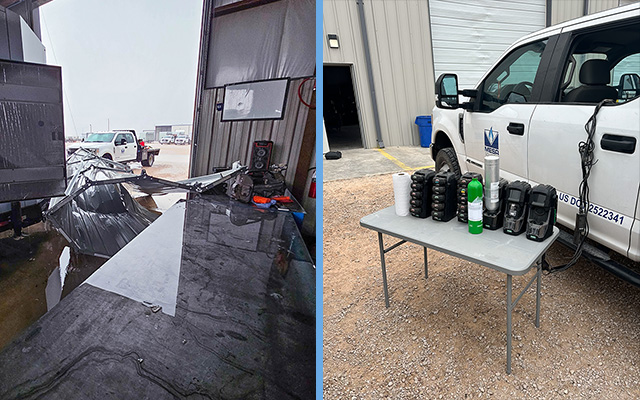Table of Contents
To continue our series on the 12 Rules of Leadership (as taught by Jocko Willink in the book, Leadership Strategy and Tactics), let’s look at the next set of three rules. Rules 7, 8, and 9 all talk about qualities that are sometimes difficult to achieve as a leader. These rules force the leader to look inward and see if his or her daily decisions are affecting the team. Read below for some insights from leaders within the Mesa Organization. (This title is on the Mesa Solutions’ reading list, which you can find here.)
Rule of Leadership #7: Work Hard. As the leader, you should be working harder than anyone else on the team. No job is beneath you.
“Working alongside Rich King, I have been repeatedly amazed at how he continually sets a great example of working just as hard or harder than his team. If he needed anyone to work through the night or through the weekend, he was there working side by side with them. He has always jumped in and done all the dirty work as far as cleaning up the shop, digging in, and getting his hands dirty for an oil change or a valve set. He sets the example of working hard physically and mentally on a problem.
“Two specific examples come to mind. First, Rich jumped in and helped troubleshoot and collect data with technicians and engineers in North Dakota to fix unit freeze-ups from the cold. He worked throughout the night in at least one instance, in the dead of winter, in order to get to the bottom of what was happening inside the units and causing freeze-ups. Second, Rich traveled countless trips to the field to collect and analyze data to troubleshoot engine knock retard when we unexpectedly got new calibrations and new knock detection. He was relentless and meticulous in analyzing engine health, field conditions, and other variables and worked with technicians to come up with theories on what was going on and to figure out ways to prove or disprove those theories.
“His work ethic is contagious and comes from a big heart. That’s the true sign of a leader, and it’s motivating to work next to someone like that.”
Chris Piasecki, Chief Technology Officer
Rule of Leadership #8: Have Integrity. Do what you say; say what you do. Don't lie up or down the chain of command.
“Integrity, as I understand it, is maintaining honesty, moral principles, and virtues. This characteristic has always been in the foreground of my life, and I was taught by a great man of integrity, my father. With integrity, you do what is right, whether witnessed or not. Integrity is setting an internal standard yet being open to the insights of others and maintaining that honesty with yourself and others.
“When we started Mesa, there was no doubt that integrity played a vital role in our success. We knew the backbone of the business was the employees. To our employees, customers, and vendors, we give respect, take ownership, and earn trust. That being said, I will leave you with a quote form Marcus Aurelius: ‘If it is not right, don’t do it. If it is not true, don’t say it.'”
Rich King, Chief Maintenance Officer
Rule of Leadership #9: Be Balanced. Extreme actions and opinions are usually not good.
“Balance is essential when stepping into a new leadership role, but what does being balanced mean? I can tell you a long boring explanation, but instead, I wanted to give a simple example in terms that everyone at Mesa can relate to.
“When I started as a young Field Office Lead, I thought I needed to make calls in the heat of the moment and drop the hammer when my team didn’t respond like I wanted them to or do precisely what I wanted to be done or how I wanted it done. So, guess what I would do? I would jump the gun and act on emotion, which isn’t balanced! I would raise my voice and get upset instead of asking the team WHY. Even more importantly, I wouldn’t own the fact that it was on me; it was my fault that they didn’t do what I needed because I didn’t give them any buy-in. For example, I had this one tech who would always fight me with every decision I made and do everything he thought needed to be done. Then he would drop the ball, and I would have to get the team together to fix the issues; instead of asking him why he thought I wasn’t making a good call, I would just act on my emotions, tear him down, and move on. What I didn’t realize was that every time I worked like that, I would be spending my leadership capital but in a negative way. With this particular individual, I spent so much of that capital I had to take loans from my boss and team to pay my dues! Part of being balanced is taking a step back and accessing the situation before acting on emotions.
Cody Dalton, Maintenance Shop Chief
Check back in a few months for the final part of this 4-part series.
You can find Part 1 here.
You can find Part 2 here.
As a preview, here are the remaining three rules:
- Be decisive. When it is time to make a decision, make one.
- Build Relationships. That is your main goal as a leader. A team is a group of people who have
relationships and trust one another. Otherwise, it is just a disconnected, incoherent cluster of
people. - Lastly, get the job done. That is the purpose of a leader—to lead a team in accomplishing a
mission. If you don’t accomplish the mission, you fail as a leader. Performance counts.












